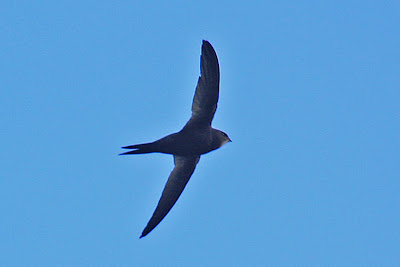This is the time of the year when we start seeing large flocks of birds gathering. There are already quite sizable groups of Starlings around and many of the fields are full of Rooks.
 Of course they're not all Rooks, and when they are together it's useful to compare Rooks and Crows. The shape of the head and beak are quite different. The Carrion Crow above has a stout strong bill, quite able to deal with the carrion it's named after. Rooks, especially those that live alongside motor ways have learnt to take advantage of carrion as well, but their beaks have evolved differently.
Of course they're not all Rooks, and when they are together it's useful to compare Rooks and Crows. The shape of the head and beak are quite different. The Carrion Crow above has a stout strong bill, quite able to deal with the carrion it's named after. Rooks, especially those that live alongside motor ways have learnt to take advantage of carrion as well, but their beaks have evolved differently. The Rooks beak is long and pointed and is used for probing in the ground. They will take seeds that have been sown but overall they do more good than harm with the number of pest species they take from the soil.
The Rooks beak is long and pointed and is used for probing in the ground. They will take seeds that have been sown but overall they do more good than harm with the number of pest species they take from the soil. This evening I noticed a lot of Swifts coming low over the garden, and once again tried to get an in focus picture, it really isn't easy, how these guys get pictures of rare Swifts as the zoom over I don't know. I had a choice of birds in the air and still found it very hard to get one focused in the viewfinder.
This evening I noticed a lot of Swifts coming low over the garden, and once again tried to get an in focus picture, it really isn't easy, how these guys get pictures of rare Swifts as the zoom over I don't know. I had a choice of birds in the air and still found it very hard to get one focused in the viewfinder. I popped down to the bay to see if there was any evidence of Swifts moving by along the Channel. I didn't see any and I certainly didn't see any of these fisherman catch anything. It's unusual to see so many in the bay. Tim Burden tells me that there's been a seal around in the Bay for a few days, I haven't managed to see it but I would think that it would put any fish off from feeding in the bay.
I popped down to the bay to see if there was any evidence of Swifts moving by along the Channel. I didn't see any and I certainly didn't see any of these fisherman catch anything. It's unusual to see so many in the bay. Tim Burden tells me that there's been a seal around in the Bay for a few days, I haven't managed to see it but I would think that it would put any fish off from feeding in the bay. It unusual to see a shipped moored not far off shore and I wondered about the Syros. It's the name of a Greek Island, and also the name of a Greek ship involved in an oil spill near Montevideo on June 4th, that caused a lot of environmental damage. I don't think it could have been this vessel but I don't know how common the name is.
It unusual to see a shipped moored not far off shore and I wondered about the Syros. It's the name of a Greek Island, and also the name of a Greek ship involved in an oil spill near Montevideo on June 4th, that caused a lot of environmental damage. I don't think it could have been this vessel but I don't know how common the name is.And for my friends in South Africa: The English test team did OK today, South Africa followed on 346 behind (and they can't fiddle us out of a try in cricket!).


No comments:
Post a Comment